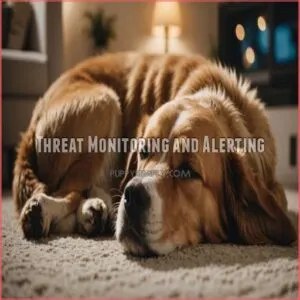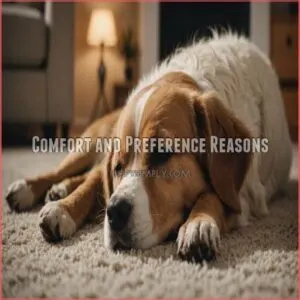This site is supported by our readers. We may earn a commission, at no cost to you, if you purchase through links.
 Ever wondered why dogs sleep with their bum facing you? It’s all about trust and protection.
Ever wondered why dogs sleep with their bum facing you? It’s all about trust and protection.
This quirky habit is like a dog’s way of saying, "I’ve got your back."
By facing away, they can keep an eye on the environment, making sure all’s well.
It’s also a sign of comfort—they’re so relaxed around you that they show their most vulnerable side.
Plus, this position helps them avoid unwanted cuddles while still staying close.
This posture hints at their deep affection and instinct to protect their pack.
Dogs often exhibit behaviors like sleeping on their owner’s pillow due to their innate need for a sense of safety and belonging. Curious about other reasons behind this canine behavior? Stick around for more insights!
Table Of Contents
- Key Takeaways
- Trust and Affection Signs
- Protection and Security Instincts
- Comfort and Preference Reasons
- Scent Marking and Temperature Regulation
- Pack Mentality and Social Hierarchy
- Timidity and Anxiety Factors
- Frequently Asked Questions (FAQs)
- Why does my dog sleep with its bum facing me?
- Why do dogs sleep with their butt facing you?
- Why do dogs turn their bums towards their owners?
- Why do dogs sleep on their backs?
- What does it mean when your dog sleeps facing away from you?
- Do dogs protect you when you sleep?
- Why do dogs sleep touching you?
- Why does my dog sit in my spot when I get up?
- Why do dogs prefer specific sleeping spots?
- Do all dog breeds exhibit this behavior?
- How do puppies differ in sleeping positions?
- Can diet affect a dogs sleeping habits?
- Does a dogs age influence sleeping positions?
- Conclusion
Key Takeaways
- Your dog’s bum-facing sleep position is a sign of trust and comfort, indicating they’re relaxed and view you as part of their pack.
- This position allows your dog to protect you by keeping an eye on the environment while showing affection and bond.
- Dogs sometimes choose this posture to regulate body temperature, using it as a natural thermostat while sleeping.
- They avoid direct face-to-face contact for personal comfort, finding relaxation in maintaining a slight distance.
Trust and Affection Signs
You might think your dog’s sleeping position is random, but it’s actually a sign of trust.
When your furry friend snoozes with their bum facing you, they’re showing they feel safe and secure in your presence.
Vulnerable Side Exposure
Ever notice your furry friend snoozing with their backside on display?
It’s not just a quirky habit—it’s a powerful trust signal, similar to when they roll on their backs for submission.
By exposing their vulnerable side, your pup’s body language speaks volumes about their comfort level.
It’s like they’re saying, "I’ve got your back, and I know you’ve got mine."
Pretty touching, right?
Strong Bond Indication
When your furry friend sleeps with their bum facing you, it’s like they’re giving you a canine high-five.
This position speaks volumes about the bond you share.
It’s not just about dog sleeping habits; it’s a sign of deep dog trust.
Your pup’s showing you they’re comfortable enough to let their guard down.
This behavior, along with tail wags and playful antics, indicates a strong connection.
It’s their way of saying, "You’re my person, and I feel safe with you.
Comfort and Security
Your furry friend’s sleeping position speaks volumes about their comfort and security.
When your dog snoozes with their bum facing you, it’s a cozy sign of canine trust.
This endearing dog body language reveals:
- A secure attachment to you
- Confidence in their safe sleeping spot
- Reduced stress and anxiety
- A strong owner-dog bond
By avoiding ventral contact, your pup finds ultimate canine comfort.
It’s like they’re saying, "I’ve got your back, and I know you’ve got mine!
Long-Term Owner Bonding
Dogs who’ve been with you for years often sleep with their bums facing you.
It’s like they’re saying, "I’ve got your back!"
This quirky habit shows how much they trust you.
Over time, you’ve become their safe haven.
They’re comfortable enough to let their guard down, exposing their vulnerable side.
It’s a strong indicator of the bond you’ve built through countless shared experiences and daily routines.
Love and Affection Expression
Believe it or not, your furry friend’s bum-facing sleep position is a love letter in disguise!
By exposing their vulnerable side, they’re saying, "I trust you completely."
It’s like a canine hug, minus the awkward ventral contact.
This sleeping habit, along with tail wags and happy barks, showcases their deep affection.
So next time you’re tempted to nudge that furry behind, remember it’s your pup’s way of snuggling up close!
Protection and Security Instincts
You might be surprised to learn that your dog’s sleeping position serves a protective purpose.
When your furry friend snoozes with their bum facing you, they’re actually on guard duty, keeping an eye out for potential threats while trusting you to watch their back.
Threat Monitoring and Alerting
While snoozing with their rear facing you might seem odd, it’s actually a clever canine strategy.
This position allows your furry friend to keep an eye on potential threats while feeling safe near you.
It’s like they’re saying, "I’ve got your back!"
Here’s what this protective posture tells us:
- They’re on high alert for any suspicious noises or movements
- Their body language is primed for quick reaction
- They’re using their keen senses to guard your shared territory
Natural Protective Instincts
Your furry friend’s protective instincts kick in even during naptime.
When your pooch snoozes with their bum facing you, they’re on guard duty.
This position allows them to scan the room for potential threats while keeping you safe.
It’s like having your own personal, four-legged security system!
This behavior stems from their wild ancestors’ need to protect the pack.
Pretty clever, right?
Pack Member Protection
Dogs sleeping with their bum facing you isn’t just cute; it’s a powerful pack protection strategy.
By positioning themselves this way, they’re on guard duty, ready to alert you to potential threats.
Playing with the right dog toys for security can also help reinforce this instinct.
It’s like having a furry security system!
This behavior taps into their territorial instincts, allowing them to keep an eye on the environment while still staying close to their beloved pack member – you!
Loyalty and Vigilance
At bedtime, your furry friend’s loyalty shines through.
When dogs sleep with their bum facing you, they’re on guard duty.
This position lets them keep an eye on potential threats while staying close to you.
It’s a sign of their protective instincts and pack behavior.
Your pup’s showing love by watching over you, even in their sleep.
Talk about a loyal companion!
Environmental Awareness
Every dog’s got a built-in radar for their surroundings.
When they sleep with their bum facing you, they’re on high alert.
Their keen senses pick up on environmental cues you might miss.
From subtle noises to changes in air currents, they’re tuned in to potential threats.
This sleeping position lets them react quickly if needed, keeping both of you safe.
It’s like having your own furry security system!
Comfort and Preference Reasons
You might be surprised to learn that your dog’s sleeping position is all about comfort and personal preference.
Dogs often choose to sleep with their bum facing you because they find it relaxing and it helps them avoid face-to-face contact, which some pups find a bit too intense for a good night’s rest.
Ventral Contact Avoidance
Unlike us, your furry friend isn’t a fan of face-to-face cuddles.
They’re wired to avoid ventral contact, which explains why they turn their bum your way.
It’s not personal – it’s just how they’re built.
This behavior starts in puppies and varies across breeds.
Some dogs are more sensitive to touch, especially if they’re dealing with pack mentality and scent marking, like when they lie on their owners.
Understanding this quirk helps you respect your pup’s comfort zone.
Calming and Comforting Position
Curled up with their bum facing you, your furry friend finds comfort in this cozy position.
It’s like they’re giving you a fuzzy high-five with their tail!
This back-to-back sleeping style helps relieve anxiety and promotes relaxation.
Your dog’s body language speaks volumes – they’re showing you they’re at ease.
So next time you see that adorable tush, know it’s a sign of trust and contentment.
Natural Instinct Avoidance
Dogs often sleep with their bums facing you to avoid ventral contact, which can feel uncomfortable or threatening.
It’s like they’re saying, "I love you, but let’s keep some personal space!"
This defensive posture allows them to maintain negative space while still staying close.
By facing away, they’re following their instincts to protect vulnerable areas.
It’s their way of seeking comfort while maintaining pack hierarchy.
Pretty clever, right?
Touch Sensitivity
While some pups are cuddle bugs, others might be touch-sensitive.
Your furry friend’s bum-facing sleep position could be their way of saying, "I love you, but please don’t pet me right now."
This touch sensitivity can stem from various factors, including past experiences or breed traits.
By respecting your dog’s comfort zone, you’re strengthening your bond and reducing potential stress indicators.
Remember, a little space can go a long way in keeping your pooch happy and relaxed.
Personal Preference and Relaxation
Just like you have a favorite sleeping position, your furry friend does too!
Some pups prefer to snooze with their bum facing you.
It’s all about comfort and relaxation.
This doggy sleep style might look funny, but it’s one of their preferred positions.
Your pooch is simply finding their comfort zone, settling into a relaxed posture that feels just right for them.
Scent Marking and Temperature Regulation
Your dog’s bum-facing sleep position isn’t just a quirky habit—it’s a clever way to mark you with their scent and control their body temperature.
This dual-purpose posture helps your furry friend claim you as part of their pack while staying comfy, whether they’re trying to cool down or warm up.
Scent Marking and Pack Identification
After finding the perfect spot for comfort, your furry friend might aim their bum your way for a sniff-worthy reason.
They’re not just sleeping; they’re leaving a scent mark from their glands to strengthen social bonds.
This little canine communication helps define pack hierarchies and signals, "You’re part of my circle."
It’s a unique way dogs affirm friendship and security.
Body Temperature Regulation
So, your dog’s leaving a scent message? That’s one reason!
But did you know their sleeping position also helps regulate their body temperature? It’s all about heat dissipation; they might position themselves to stay cool or warm. Think of it as their built-in thermostat!
Their fur thickness plays a role, too. Clever, huh? Different sleeping positions help them find their perfect temperature.
Climate Adaptation and Comfort
Ever noticed your dog’s unique resting habits during chilly nights or sweltering days?
Dogs adapt their sleeping positions to handle temperature regulation.
This bum-facing posture helps them manage heat dissipation or enhance cold adaptation.
By adjusting to seasonal variations, they stay cozy without a fuss.
Remember, your pup’s sleeping habits aren’t random—it’s climate comfort in action!
Natural Instinct Expression
Imagine your dog snoozing with its bum facing you.
It’s not just a preference; it springs from evolutionary roots.
Dogs instinctively mark pack members with scent, wrapping you in their invisible hug.
Plus, this helps regulate body temperature effectively.
Whether it’s cold or warm, your furry friend, especially bulldogs who display signs of happiness through relaxed eye contact and a healthy appetite, intuitively knows the best way to get cozy how to spot happy bulldogs.
Comfort and Relaxation
Perhaps it’s not just you who’s comfort preferences.
Dogs delight in relaxation techniques for better sleep quality.
Why bum to you? They’re marking territory, staying cool or warm, and seeking stress relief.
Look:
- Scent marking for pack identity
- Temperature balance in hot or cold
- Cozy comfort for muscle ease
- Security signals unconsciously
- Naturally instinctive position
Pack Mentality and Social Hierarchy
When your dog sleeps with their bum facing you, it’s like their way of saying, “I’m part of the pack, and here’s my spot!”
This behavior reflects their instinctive social structure, helping them establish where they fit within the household hierarchy.
Dominance and Submission Expression
Dog body language can be a bit of a puzzle, but your pup might just be signaling submission or dominance when they snooze with their bum facing you.
It’s all about pack dynamics and picking up social cues.
Hierarchy signals keep the peace without battles.
Let’s peek into a dog’s mind with this brief table:
| Behavior | Meaning | Example |
|---|---|---|
| Tail Wagging | Happy or Alert | Greeting You |
| Ears Back | Submissive Behavior | Meeting New Dogs |
| Bum Facing | Trust & Submission | Sleeping Position |
| Eye Contact | Challenge or Affection | Training Sessions |
| Barking | Communication | Alerting Intruders |
Hierarchy Establishment
So, your dog’s sleeping position might actually reveal something about your household’s social order.
It’s all about pack dynamics!
Sometimes, a bum-to-you sleep means they’re comfortable with their place in the pack.
Here’s what that might mean:
- They feel secure in your presence.
- They’re not vying for Alpha status.
- They trust you implicitly.
- They’re displaying submission cues.
Pack Animal Instincts
Your dog’s bum-facing routine speaks volumes about pack mentality and social hierarchy.
This behavior can also be influenced by their natural instincts as guard dogs, such as those seen in breeds with protective aggression.
By positioning themselves this way, dogs subtly communicate their place within your family’s pack hierarchy.
A little bum wiggle can actually be a display of dominance or submission, depending on the setting.
It’s their way of scent communication and social signaling, maintaining group dynamics without saying a word.
Social Bonding and Structure
Sleepy pups show their trust and place in the pack by sleeping with their bums facing you.
In the wild world of pack dynamics, they send social signals and communication cues through this quirky position.
It’s their way of keeping tabs on the dominance hierarchy and showing where they fit in.
It’s like their version of a friendly handshake!
Multi-Dog Household Dynamics
Living with multiple dogs can be like orchestrating a furry symphony.
Dogs’ sleeping positions may reflect their understanding of pack dynamics and hierarchy.
Here are three key aspects:
- Social dominance: Sleeping bum first can show submission or dominance.
- Resource guarding: Protecting their space and resources.
- Play and interaction: Fostering bonds within the pack.
Timidity and Anxiety Factors
Dogs might sleep with their bum facing you because they’re feeling a bit timid or anxious, avoiding direct eye contact as they warm up to their surroundings.
This behavior is especially common in pets who’ve experienced past trauma, so it’s important to give them space, patience, and understanding while they build trust and confidence in their new environment.
Avoiding Eye Contact and Intimacy
An often-overlooked behavior is your dog’s bum-facing antics, which signal shyness or timidity.
In the dog’s world, avoiding eye contact is a non-verbal cue indicating they’re still getting comfortable.
Like us dodging eye contact in awkward encounters, shy dogs express their anxiety this way.
Remember, understanding these social cues helps in trust building.
| Factor | Explanation | Outcome |
|---|---|---|
| Dog Body Language | Bum-facing posture | Signals timidity |
| Social Cues | Avoids direct eye contact | Shows discomfort |
| Non-Verbal Communication | Shy dog’s behavior | Needs patience |
Adjustment and Trust Building
With a new dog, you’re diving into the adjustment and trust-building phase.
It’s like setting up a comfy spot for fear and trust to share a cup of tea.
Your pup’s bum-facing pose during bonding time reflects their gradual journey to building confidence.
Sprinkle in positive reinforcement, and soon enough, you’ll both bask in the warm glow of mutual trust.
Past Trauma and Abuse
Because of past trauma, your dog might sleep with its bum facing you.
This isn’t necessarily bad; it might show they’re still learning to trust.
Here’s what that means:
- Trauma Impact: Past abuse can make dogs anxious.
- Abuse Signs: Avoidance of eye contact is a common sign.
- Recovery Stages: It takes time and patience.
- Trust Building: Create a safe space for them. Building trust takes time, but it’s achievable.
Patience and Understanding Importance
Imagine your pup’s past trauma: it may swerve bum-first when sleepy.
You’re rebuilding a shattered bridge.
Patience and understanding are your best tools in this delicate dance.
Here’s a quick look at handling timidity:
| Approach | Benefit |
|---|---|
| Calm Tones | Reduces fear |
| Slow Movements | Builds comfort |
| Safe Space | Encourages relaxation |
| Consistent Routine | Fosters security |
| Soft Praise | Sparks trust |
Building Trust and Confidence
Building trust takes time, especially with a timid dog.
Observing their body language can guide you.
Use these gentle techniques:
- Calming techniques: Create a peaceful environment.
- Positive reinforcement: Reward bravery.
- Consistent routines: Offer stability.
- Building trust: Encourage closeness at their pace.
- Understanding nervous signals: Be patient.
With these, you’ll help them flourish confidently.
Frequently Asked Questions (FAQs)
Why does my dog sleep with its bum facing me?
Your dog may sleep with its bum facing you to show trust and affection.
This position can also signal protection instincts, comfort preferences, or even a way to regulate temperature.
It’s a sign of your strong bond.
Why do dogs sleep with their butt facing you?
Dogs sleep with their butts facing you as a sign of trust and comfort.
This position lets them keep watch over the room, feel secure from threats, and avoid uncomfortable face-to-face contact.
It’s both protective and affectionate.
Why do dogs turn their bums towards their owners?
Ever wondered about that doggy butt-to-human pose?
It’s a sign of deep trust!
They’re showing vulnerability, feeling safe and secure with you.
It’s their way of saying, "I love you, human!
Why do dogs sleep on their backs?
When dogs sleep on their backs, they’re showing trust and comfort.
This position cools them down as it exposes their belly to air.
It’s also a sign they’re relaxed, feeling safe, and secure in their environment.
What does it mean when your dog sleeps facing away from you?
Your dog might sleep facing away from you to express trust, as this position exposes their vulnerable side.
They could also be protecting you by watching for threats.
Or, they might simply find this position more comfortable and relaxing.
Do dogs protect you when you sleep?
Dogs can protect you while you sleep, acting as natural guardians.
They stay alert to detect any unusual sounds or movements, making them great night watchmen.
Their protective instinct stems from loyalty and their role as pack members.
Why do dogs sleep touching you?
Sleeping near their owners makes dogs feel safe and secure.
It allows them to sense their owner’s presence and pick up on their scent.
This provides comfort and reassurance through physical closeness.
Why does my dog sit in my spot when I get up?
When you get up, your dog might sit in your spot because it’s warm and cozy, or they enjoy your scent.
This behavior can also show their desire to feel close to you in your absence.
Why do dogs prefer specific sleeping spots?
Perfect positioning provides pups peace. They pick places offering warmth, safety, and comfort; it’s all about personal preference and feeling secure. Snug spots signal serenity!
Do all dog breeds exhibit this behavior?
Not all dog breeds exhibit the behavior of facing you with their bums.
It depends on individual personalities, comfort levels, and instincts.
Some dogs feel secure and affectionate this way, while others might prefer different positions.
How do puppies differ in sleeping positions?
Picture a wiggling ball of fur!
Puppies often curl up in tight little balls or sprawl out with carefree limbs.
As they grow, they experiment with these positions for security or comfort, learning what feels best.
Can diet affect a dogs sleeping habits?
Yes, diet can affect your dog’s sleep.
A balanced diet supports good rest, while poor nutrition may cause discomfort or restlessness.
Think about swapping out those midnight snacks for balanced meals to help their sleep.
Does a dogs age influence sleeping positions?
As dogs age, their sleeping positions often shift due to comfort needs.
Puppies and older dogs, especially those experiencing older dog attacking puppy aggression, might require careful introductions and separate resting areas for comfort. Puppies and older dogs might favor curling up for warmth or support.
Just like us, dogs seek positions that ease pressure on their joints.
Conclusion
Imagine your dog sleeping with its bum facing you as a warm hug from behind—comforting and protective.
This quirky habit speaks volumes about their trust, affection, and instincts.
Whether it’s about keeping an eye on the environment, expressing comfort, or marking their spot, your furry friend’s sleeping position says a lot about their feelings.
Next time they do it, remember it’s a mix of love, safety, and their natural instincts.
Now you know!
















